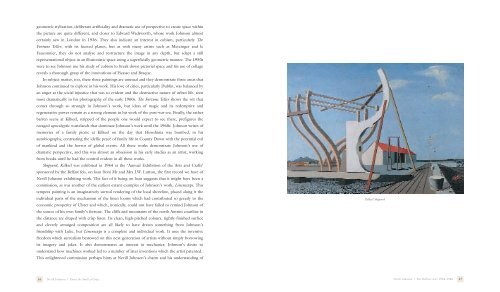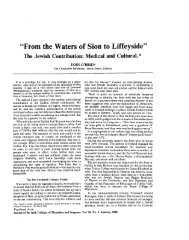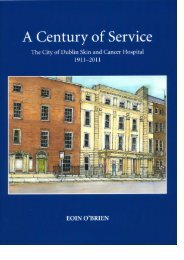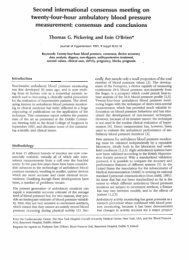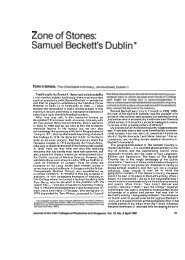Nevill Johnson: Paint the smell of grass - Eoin O'Brien
Nevill Johnson: Paint the smell of grass - Eoin O'Brien
Nevill Johnson: Paint the smell of grass - Eoin O'Brien
Create successful ePaper yourself
Turn your PDF publications into a flip-book with our unique Google optimized e-Paper software.
geometric stylization, deliberate artificiality and dramatic use <strong>of</strong> perspective to create space within<br />
<strong>the</strong> picture are quite different, and closer to Edward Wadsworth, whose work <strong>Johnson</strong> almost<br />
certainly saw in London in 1936. They also indicate an interest in cubism, particularly The<br />
Fortune Teller, with its faceted planes, but as with many artists such as Metzinger and le<br />
Fauconnier, <strong>the</strong>y do not analyse and restructure <strong>the</strong> image in any depth, but adapt a still<br />
representational object in an illusionistic space using a superficially geometric manner. The 1950s<br />
were to see <strong>Johnson</strong> use his study <strong>of</strong> cubism to break down pictorial space and his use <strong>of</strong> collage<br />
reveals a thorough grasp <strong>of</strong> <strong>the</strong> innovations <strong>of</strong> Picasso and Braque.<br />
In subject matter, too, <strong>the</strong>se three paintings are unusual and <strong>the</strong>y demonstrate three areas that<br />
<strong>Johnson</strong> continued to explore in his work. His love <strong>of</strong> cities, particularly Dublin, was balanced by<br />
an anger at <strong>the</strong> social injustice that was so evident and <strong>the</strong> destructive nature <strong>of</strong> urban life, seen<br />
most dramatically in his photography <strong>of</strong> <strong>the</strong> early 1960s. The Fortune Teller shows <strong>the</strong> wit that<br />
comes through so strongly in <strong>Johnson</strong>’s work, but ideas <strong>of</strong> magic and its redemptive and<br />
regenerative power remain as a strong element in his work <strong>of</strong> <strong>the</strong> post-war era. Finally, <strong>the</strong> ra<strong>the</strong>r<br />
barren scene at Kilkeel, stripped <strong>of</strong> <strong>the</strong> people one would expect to see <strong>the</strong>re, prefigures <strong>the</strong><br />
ravaged apocalyptic wastelands that dominate <strong>Johnson</strong>’s work until <strong>the</strong> 1960s. <strong>Johnson</strong> writes <strong>of</strong><br />
memories <strong>of</strong> a family picnic at Kilkeel on <strong>the</strong> day that Hiroshima was bombed, in his<br />
autobiography, contrasting <strong>the</strong> idyllic peace <strong>of</strong> family life in County Down with <strong>the</strong> potential evil<br />
<strong>of</strong> mankind and <strong>the</strong> horror <strong>of</strong> global events. All <strong>the</strong>se works demonstrate <strong>Johnson</strong>’s use <strong>of</strong><br />
dramatic perspective, and this was almost an obsession in his early studies as an artist, working<br />
from books until he had <strong>the</strong> control evident in all <strong>the</strong>se works.<br />
Shipyard, Kilkeel was exhibited in 1944 at <strong>the</strong> ‘Annual Exhibition <strong>of</strong> <strong>the</strong> Arts and Crafts’<br />
sponsored by <strong>the</strong> Belfast feis, on loan from Mr and Mrs J.W. Lutton, <strong>the</strong> first record we have <strong>of</strong><br />
<strong>Nevill</strong> <strong>Johnson</strong> exhibiting work. The fact <strong>of</strong> it being on loan suggests that it might have been a<br />
commission, as was ano<strong>the</strong>r <strong>of</strong> <strong>the</strong> earliest extant examples <strong>of</strong> <strong>Johnson</strong>’s work, Linenscape. This<br />
tempera painting is an imaginatively surreal rendering <strong>of</strong> <strong>the</strong> local shoreline, placed along it <strong>the</strong><br />
individual parts <strong>of</strong> <strong>the</strong> mechanism <strong>of</strong> <strong>the</strong> linen looms which had contributed so greatly to <strong>the</strong><br />
economic prosperity <strong>of</strong> Ulster and which, ironically, could not have failed to remind <strong>Johnson</strong> <strong>of</strong><br />
<strong>the</strong> source <strong>of</strong> his own family’s fortune. The cliffs and mountains <strong>of</strong> <strong>the</strong> north Antrim coastline in<br />
<strong>the</strong> distance are draped with crisp linen. Its clean, high-pitched colours, tightly-finished surface<br />
and cleverly arranged composition are all likely to have drawn something from <strong>Johnson</strong>’s<br />
friendship with Luke, but Linenscape is a complete and individual work. It uses <strong>the</strong> inventive<br />
freedom which surrealism bestowed on this next generation <strong>of</strong> artists without simply borrowing<br />
its imagery and jokes. It also demonstrates an interest in mechanics; <strong>Johnson</strong>’s desire to<br />
understand how machines worked led to a number <strong>of</strong> later inventions which <strong>the</strong> artist patented.<br />
This enlightened commission perhaps hints at <strong>Nevill</strong> <strong>Johnson</strong>’s charm and his understanding <strong>of</strong><br />
16 <strong>Nevill</strong> <strong>Johnson</strong> l <strong>Paint</strong> <strong>the</strong> Smell <strong>of</strong> Grass<br />
Kilkeel Shipyard<br />
<strong>Nevill</strong> <strong>Johnson</strong> l The Belfast years 1934–1946 17


